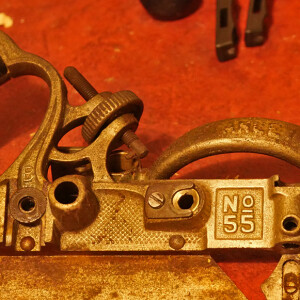The Stanley #55. Leica/Lumix Macro-Elmarit 45mm
Whenever I have had to make moldings by hand in the last few years, I have debated whether I should try to find an example of the absolute undisputed king of combination planes, the venerable Stanley #55. But when I have looked at the prices which they command, my eyes started to water, and I have scrapped the idea. Having just finished my latest round of molding production for The Contraption, I went to search online for a #55. Well, this time I found what I was looking for: one in basically sound condition, just the plane, none of the accessories or cutters, - a good thing because I've acquired those over several years -, and most importantly, filthy dirty! That brought the price way down. The plane showed up a couple of days ago and I have begun the lengthy process of restoring this relic to pristine condition. My sense is that it had been sitting in a barn somewhere for decades, some tarnish but no deep, pitting rust.
For the purposes of the Blip, I cleaned the lovely logo cast into the body of the plane. A spritz of WD-40, a few minutes to soak in, and then a scrub with a brass wire brush. In the background can be seen part of the sliding section, as yet uncleaned. Under the grime of decades, it says Stanley. The Extra gives a more general idea of the plane.
The #55 was in production from 1897 until 1962, a long innings during which time it went through many subtle changes, usually simplifications to make it cheaper to produce. For the average tradesman, it must have represented a significant investment. Stanley's sales pitch at the time was that their plane came with 55 different cutters and could do anything a joiner or cabinet maker required, replacing the collection of dedicated wooden molding planes present in every workshop.
The handles, knobs and fences of the 55 are of rosewood, discontinued between the World Wars, I believe. The plane is a lovely thing, ingenious and fiendishly complicated, and there's definitely a learning curve involved to get the best results out of it.
I took the whole thing apart today, and made a trip to the hardware store for a basin in which to immerse everything, a couple of stiff wire brushes, and a generous spray can of WD-40. Then a trip to the convenience store across the street for a 2 litre bottle of Coca-Cola. It is well-known that the phosphoric acid in Coke is a great rust remover...


Comments
Sign in or get an account to comment.


